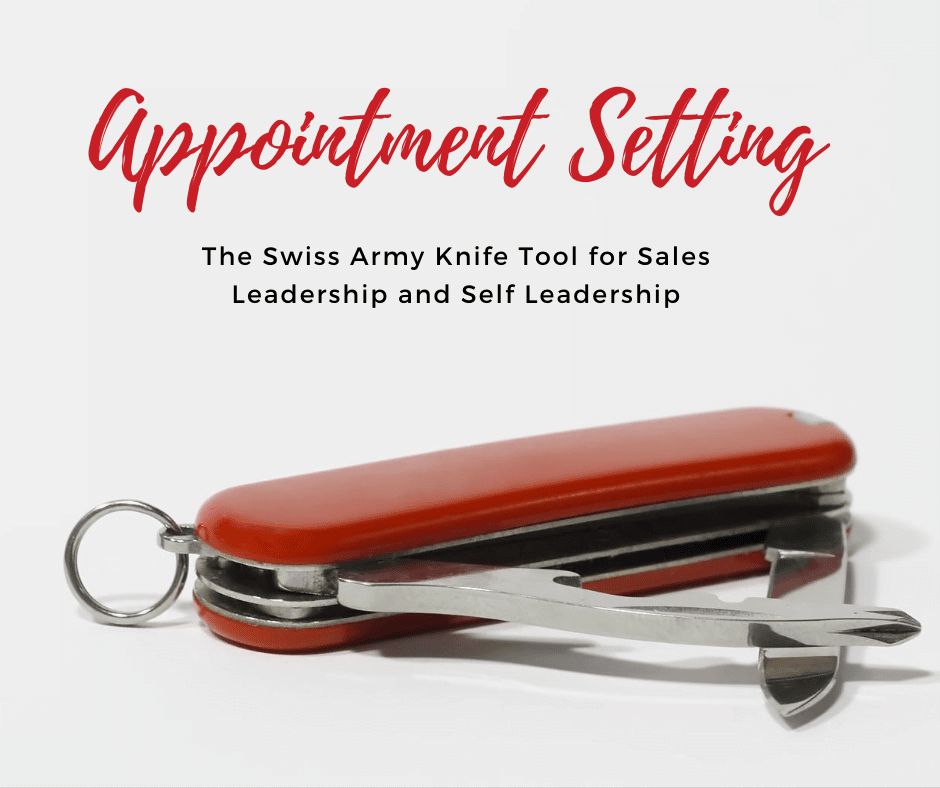
Appointment setting is the Swiss Army Knife of tools for both business life and personal life. It’s portable, useful, multifunctional, and adapts well whether you are working from home or in a skyscraper. That’s what this article is about, the concept of appointment setting as a tool, a tool for business leadership, such as sales appointment setting, or a tool for life for just about anything you need to achieve. Appointment setting is one of the best tools in the universe to not only achieve business success, but personal growth and development as well.
Appointment setting is an ancient concept as old as time, or at least as old as recorded time and calendars have been around. Who knows how long the concept of placing an appointment on a calendar has been around? In the movie Michael, the Archangel Michael, played by John Travolta, explains how he invented waiting in line. Maybe Michael was the same one to invent appointment setting. One thing is sure, no one living today invented calendars or appointment setting. It’s one of the many treasured ancient inventions that we still use today.
Let’s use the analogy of sales leadership. Successful sales leaders don’t leave sales performance to chance. They make it happen. They find and use the tools they need to make it happen. Those tools can be any number of accouterments, such as software, processes, or training. At first glance, we may not think of business tools as pertaining to our personal lives. However, when we think about it from that perspective, there are many tools that can apply to different facets of our daily routine and can help us in our personal lives. One of those tools is appointment setting.
Here are some of the key ways appointment setting is a useful and powerful tool:
Appointments get things started
When a date gets put onto a calendar, something happens vs. nothing happens. Here’s an example – A friend, Ava calls that you haven’t talked to in a while, and during the conversation you both agree what fun it would be to get together for dinner with Mary, Debbie and Susan. Then a week goes by, then a month, then three months. Everyone wants it to happen, but nothing is happening. You take the lead by saying, “Hey Ava, do you have your calendar handy? Let’s put a stake in the ground.” Setting the time between you and Ava provides a starting point for inviting the other three friends. Setting the appointment converts an idea into a scheduled event.
Sales leaders get things started by setting times for sales meetings and often hold standing meeting times on the same day and time each week. Sales meetings are used to kick start contests, set goals, and recognize achievements.
Appointments are a tool to get things started, keep things going and can even be an appointment you set with yourself to get your own projects started.
Appointment setting controls the process
When X number of sales appointments are set each week, that ultimately translates to X number of new customers each week. Sales leaders use appointment setting services like ours as a tool to create and predict sales growth. You can use appointment setting to set X number of appointments per week to walk with your neighbor or walk on your treadmill. Getting appointments on a calendar is a simple, yet profound tool to control the process of creating something from nothing for just about anything, from piano practice to world peace talks. It is not a way to control people, only a way tocontrol a process.
Gladiators need extra strength appointments
Sometimes the stakes are high and you need to get people to do a thing they don’t like, including getting yourself to do a thing you don’t like. There are many types of activities where people like the benefit but don’t like the task itself. They need to do it, and you need them to do it, but they don’t like to do it. That’s when you need a tool with more teeth—an upgrade from leader to gladiator. Gladiators can propel themselves over their own hurdles or help boost others up over hurdles by making it easier to “do the right thing” and harder to miss an appointment. By loading up the appointments with extra strength elements that make it uncomfortable, maybe even a little painful to miss an appointment, gladiators can use full strength, undiluted appointments to create a type of carrot and stick approach.
For example, you can change from self-leader into self-gladiator by making it more painful to not go to the gym than to go to the gym. If you find yourself avoiding the gym but you want the benefits of good health and good looks, you can gladiate your own inner demons by booking an appointment with a personal trainer. Missing an appointment with your trainer will carry consequences of not only missing the benefits of going to the gym, but it will hit you in the pocketbook as well because you had to pay the trainer fees. Another variation is to set the appointment to meet a friend at the gym, which has no negative monetary consequences but carries the cost of damaging a friendship if you miss an appointment.
Another example is that of sales leaders having appointments set for their salespeople and placing the sales appointments directly on their calendars. Placing a sales appointment directly on a salesperson’s calendar for a set date and time makes it more or less unthinkable to “burn” a sales appointment. No salesperson worth their salt would deliberately ditch a sales appointment that was handed to them on a silver platter and paid for by their company. The alternative the sales leader faces is the hurdle to try to motivate the salespeople to set their own appointments by either 1) cold calling or 2) converting warm leads to appointments. Cold calling is difficult, and salespeople often avoid it. Even calling to convert a warm lead to an appointment can be a tedious, time-consuming process when decision-makers are not easily reached due to voice mail and telephone tag. Leads soon evaporate if the reaching process goes on for long. Sales leaders transform themselves into sales gladiators by stacking the deck in favor of a successful outcome—increased sales.
Appointments bring focus and prioritization
Blocking out time creates space. Even if you are blocking out time to decide what to block out time for, it is a way to create space to allow a person to focus on something in particular. Research shows that it takes around 10,000 hours of practice to become an expert, a virtuoso in any given field, as Malcom Gladwell discusses in his popular book, Outliers. Blocking out 10,000 hours starts with blocking out the first hour. Blocking out time to take a vacation can provide psychological energy and a daily edge to fuel your pace by giving you something to look forward to. Appointments are a tool that can be used to create the future we desire by not leaving priorities to chance. The priority of an entire project or event moves up in priority in our mind by deliberate scheduling.
I will never forget something my friend’s mom said to me when I was a younger person. She said, “When you have the right tool, life is so much easier.” That is deeply profound advice that has popped into my head on many occasions. As tools go, the Swiss Army Knife has become an icon of usefulness and adaptability. That is why appointment setting is the Swiss Army Knife in the toolkit of life. Appointments are a versatile tool to be used in so many ways, including those outlined above, plus many more. The art of setting an appointment is a skill, just as learning to use any tool is a skill that can be developed and honed. Like any skill, once you have the habit and hang of it, it will travel well with you wherever you go and serve you well for life, from sales leadership to self-leadership.
About the Author

Tracie Chancellor, CEO and Founder of TeleReach Corporate, national business to business call center specializing in sales appointment setting and lead generation, based in Houston, Texas. Chancellor is an MBA graduate of the University of Houston with over 20 years hands-on sales and marketing experience, working with privately-held businesses, universities, non-profit organizations, as well as Fortune businesses in the business to business marketing space.

